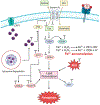Exploring the Use of Intracellular Chelation and Non-Iron Metals to Program Ferroptosis for Anticancer Application
- PMID: 39380574
- PMCID: PMC11460773
- DOI: 10.3390/inorganics12010026
Exploring the Use of Intracellular Chelation and Non-Iron Metals to Program Ferroptosis for Anticancer Application
Abstract
The discovery of regulated cell death (RCD) revolutionized chemotherapy. With caspase-dependent apoptosis initially being thought to be the only form of RCD, many drug development strategies aimed to synthesize compounds that turn on this kind of cell death. While yielding a variety of drugs, this approach is limited, given the acquired resistance of cancers to these drugs and the lack of specificity of the drugs for targeting cancer cells alone. The discovery of non-apoptotic forms of RCD is leading to new avenues for drug design. Evidence shows that ferroptosis, a relatively recently discovered iron-based cell death pathway, has therapeutic potential for anticancer application. Recent studies point to the interrelationship between iron and other essential metals, copper and zinc, and the disturbance of their respective homeostasis as critical to the onset of ferroptosis. Other studies reveal that several coordination complexes of non-iron metals have the capacity to induce ferroptosis. This collective knowledge will be assessed to determine how chelation approaches and coordination chemistry can be engineered to program ferroptosis in chemotherapy.
Keywords: chelation; ferroptosis; noniron metal complexes; regulated cell death.
Conflict of interest statement
Conflicts of Interest: The authors declare no conflicts of interest.
Figures















References
-
- Schulze-Osthoff K; Ferrari D; Los M; Wesselborg S; Peter ME Apoptosis signaling by death receptors. Eur. J. Biochem 1998, 254, 439–459. - PubMed
Grants and funding
LinkOut - more resources
Full Text Sources
